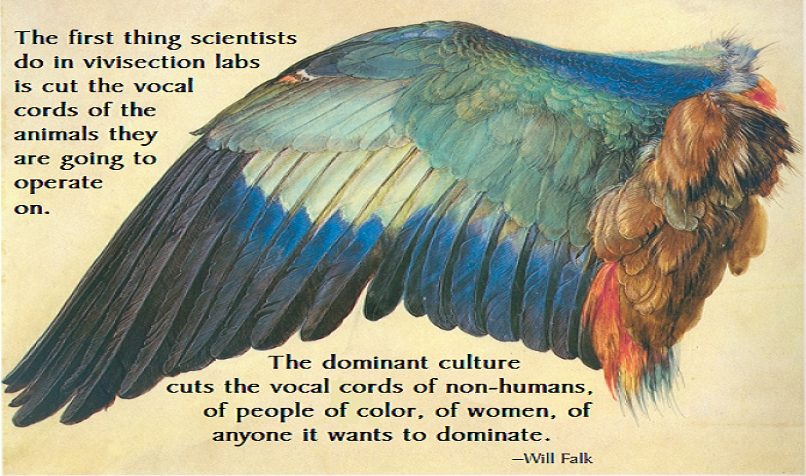
by Deep Green Resistance News Service | Nov 18, 2016 | Alienation & Mental Health, Listening to the Land
by Will Falk / Deep Green Resistance
This first appeared on Jason Howell’s Howlarium. Special thanks to Jason for his graphics.
From Jason: “Where it’s not uncommon for contemporary writers to root their work in mining—lived experience, the depth of the canon, the cultural moment, whatever—Will Falk, poet, lawyer, and environmental activist from Park City, Utah, makes the whole of his work about listening to the natural world. The effect, in this reader’s opinion, is a kind of anthropocentric-for-biocentric blood transfusion.
“I asked Will to describe what it took for him to get enough media and concrete out of the way so as to hear from the biosphere loud-and-clearly. As fate would have it, he and his partner were gearing up for a camping trip in southern Utah, so he’d have some space to think about it. Here’s what he came back with.”
Survival compels me.
My own survival, the survival of those I love, and the survival of the biosphere compel me. Listening to the land saves my life.
An old, gray seagull flying wobbly through thick, wet snow to speak to me from the concrete ledge of a window I watched Lake Michigan from while I recovered from a suicide attempt in St. Francis Hospital in Milwaukee, WI saved my life. A pregnant mother moose, who shared our single-track 17-mile snowmobile trail at the Unist’ot’en Camp turned to stare me in the eye giving me a glimpse into the wisdom of the wild, saved my life. The wind whispering questions through aspen leaves in Park City, Utah pulled me from my depressed mind a few weeks ago and, again, saved my life.
The compulsion will last as long as my survival. My survival will last as long as the compulsion. I suffer from major depressive disorder and general anxiety disorder caused by the same forces producing total ecological collapse. I must listen to the biosphere to resist depression and humans must listen to the biosphere to stop the destruction of Life.
A novice attorney, I wanted to die. I was so tired.
Before I was a writer, I was a public defender in Kenosha, WI doing my best to push back against a criminal justice system intent on perpetuating institutional racism. I spent all my time rotating between the wooden walls of the courthouse, the glass walls of the office, and the steel walls of the jail.
A novice attorney, I was determined not to let my inexperience affect my clients, but I made mistakes. The only solution I could come up with involved working more urgently and working longer hours. I woke up at 3AM to review my case files. I worked Saturdays and Sundays. I walked back to my beat Jeep Cherokee in the parking lot of the Kenosha County Jail after telling another client there wasn’t much I could do for her, and broke down sobbing with my forehead against the steering wheel in broad daylight. I became exhausted. I made more mistakes.
One night, I came home from dinner and took all the Ambien sleeping pills I had just been prescribed that morning. I wanted to die. I was so tired.
I was also living a life completely mediated by humans. This mediation was total. Physically, my life happened almost completely within atmospheres created by humans: the office, the jail, the courthouse, my apartment building. Spiritually, I had forsaken the Catholicism I was raised in, but instead of recognizing the sacred in every living being around me, my development into a mature member of a natural community stalled in an adolescent insistence that life had no meaning outside the meaning humans could create.
This insistence imprisoned me psychologically as surely as the jail physically imprisoned my clients. I became Sisyphus pushing my boulder up the hill, blind to the countless non-human others producing my life and cut off from natural allies in the biosphere.
As the pills entered my bloodstream and I settled into what I thought was my deathbed, time froze on my consciousness. I’m not sure I believe in a spiritual afterlife, but this last moment before I passed out was a functional eternity. I was confronted with the totality of my life and I realized that if I died this night, I would have failed my role. And, if the pain that was branded onto my mind with my recognition that I could give so much more to Life was the last experience frozen on my consciousness forever, then hell is very real, indeed.
A heavy snow began to fall.
After this suicide attempt, I spent a week in the psyche ward of St. Francis Hospital in Milwaukee. The St. Francis psyche ward was on the seventh floor of an eight-floor building. For exercise, and because there was nothing else to do, I braved the fluorescent lights outside my room and paced the long hallway that made up most of the seventh floor.
At each end of the hallway were wide windows. One looked west into the rows of old company housing for the Milwaukee Iron Company. The other looked east over the waters of Lake Michigan. Patients are not allowed off the seventh floor and there were rusty iron bars outside the glass just in case we were tempted to take that route to fresh air. I tried to open a window facing Lake Michigan anyway. It would not open. A heavy snow began to fall surrounding the hospital in more white. I pressed my forehead against the cold glass pane. The cold felt good.
It was not long before I saw an old spotted seagull awkwardly wheeling and diving through the falling snow. I was mesmerized by the odd gracefulness in his seemingly drunken turns through the snow. His circles brought him closer and closer to my window. I wondered why he was flying through such treacherous conditions. He was, of course, the only bird in the sky. As he flew closer, I was stricken with the beauty of his grayness against the white.
Gray. Color. A contrast to the blankness. I began to believe the drunk old gull was braving the snowstorm to speak to me. He passed a few feet from my window, dipped a wing, and wobbled back toward Lake Michigan. A few moments later he was back. He squeezed through iron bars over my window, faced me, made eye contact, and flew away.
The waves on the lake rippled gray, too. The heavy snow fell slowly, gingerly over the waters. The waves hesitated, hanging a moment in the air, before being swallowed by the lake. White became gray. I drank up the color for hours following one gray wave after another from their birthplace on the horizon until they washed not far below me onto the shore.
I was compelled to write this down. I’ve been watching and listening ever since.

Writing only for myself is masturbatory.
Depression is a chronic illness. Doctors know now that our biological stress response is largely responsible for depression. A body experiencing too much stress, for too long can overproduce stress response hormones. If these hormones are present for a long enough time they literally damage the brain. Depression results from this brain damage. The dominant culture (which I call “civilization”), based on ecological drawdown and enforced scarcity, creates profoundly stressful lives for its members.
Depression bends my mind over itself and makes listening a constant struggle. A classic depression symptom is social withdrawal and isolation. The brain reacts to depression in a similar way to other illnesses. When you get the flu, your body tells you to isolate. The same instinct is triggered with depression.
With the flu, the instinct is adaptive and good for the way it prevents contagion. But with depression the instinct can prove deadly. Isolation leads to rumination and rumination perpetuates the release of the very stress hormones that damage the brain and produce depression. In this way, withdrawal creates a vicious cycle and the cycle must be interrupted. Personally, I experience suicidal ideation too frequently making interruption of this cycle imperative for my personal survival.
Doctors strenuously encourage depressed patients to socialize even when every instinct tells them not to. Spending time with loved ones releases hormones that counteract stress hormones. Socializing also occupies the depressed mind so it cannot ruminate. When doctors insist that their patients spend time with loved ones, however, most people understand this to mean exclusively human loved ones.
That ancient seagull opened me to the vast possibilities for relationship in the natural world. The impulse to write about my experience with the seagull pulled me out of my depressed mind and gave me something to ponder beyond my own pain. I do not typically understand what non-humans are saying right away. Pinyon pine trees do not have tongues, the wind is too vast and too busy for words, and great blue herons do not speak English.
So, I have to ponder the experience. Life speaks in patterns, gestures, and themes that must be teased out. We understand through story and it is no wonder that we discover Life’s meaning in the act of telling stories. I feel that writing only for myself is masturbatory. It might feel good, but it doesn’t help anyone but me. Writing with the desire to share my experience publicly forces me to order my experience in such a way that it makes sense to other humans. In this way, writing becomes social on multiple levels. I listen to non-humans and then I begin public conversations with humans about what I think I’ve heard.
Listening to the biosphere goes well beyond my own survival.
The dominant culture exhibits many of the classic symptoms of depression as well. This culture has isolated itself from the biosphere and is suicidal—stepping ever closer to the brink of total ecological collapse.
This collapse, this suicidality, is produced, in part, by the dominant culture’s belief that humans are the only beings capable of speaking, the only beings worth listening to, the only beings capable of relating with. My friend, the brilliant environmental writer, Derrick Jensen, has given us a name for this phenomenon. He calls it “human supremacy,” and the myth of human supremacy is a foundational story the dominant culture is built upon.
Human supremacy is propagated by the dominant culture because it derives its power from ecological destruction. Before you can destroy non-human others you must silence them. Deep ecologist Neil Evernden has pointed out that the first thing scientists do in vivisection labs is cut the vocal cords of the animals they are going to operate on. The dominant culture cuts the vocal cords of non-humans, of people of color, of women, of anyone it wants to dominate.
I ignored non-human voices for too long and I almost destroyed myself as a result. The dominant culture ignores and actively suppresses non-human voices and is destroying Life as a result. I am not naive enough to believe that writing alone will stop the murder of the biosphere, but writing helps me understand non-human voices, helps me resist the seductions of depression in the process, and is a tool to remind humans of their heritage. I always seek to contribute my writing to serious, organized resistance. I believe my role in this resistance is to combat human supremacy through reminding my readers of the countless, beautiful voices—human and non-human—to listen to in the biosphere.
I am in love with aspen trees, with pinyon-juniper forests, with my one-year old nephew, with my four-year old niece, with their aunt (my amazing partner), with a rainbow trout that tickled my feet in a pool I soaked them in after a 50 mile hike in the Sierras a few summers ago, with that seagull that woke me up to it all. I am in love, so I listen, and when I listen I hear murmurs of fear about ever-growing threats. When you’re in love, you act to protect your beloved. We cannot fail to stop the dominant culture, because if we fail every voice will be silenced forever.

To repost this or other DGR original writings, please contact newsservice@deepgreenresistance.org
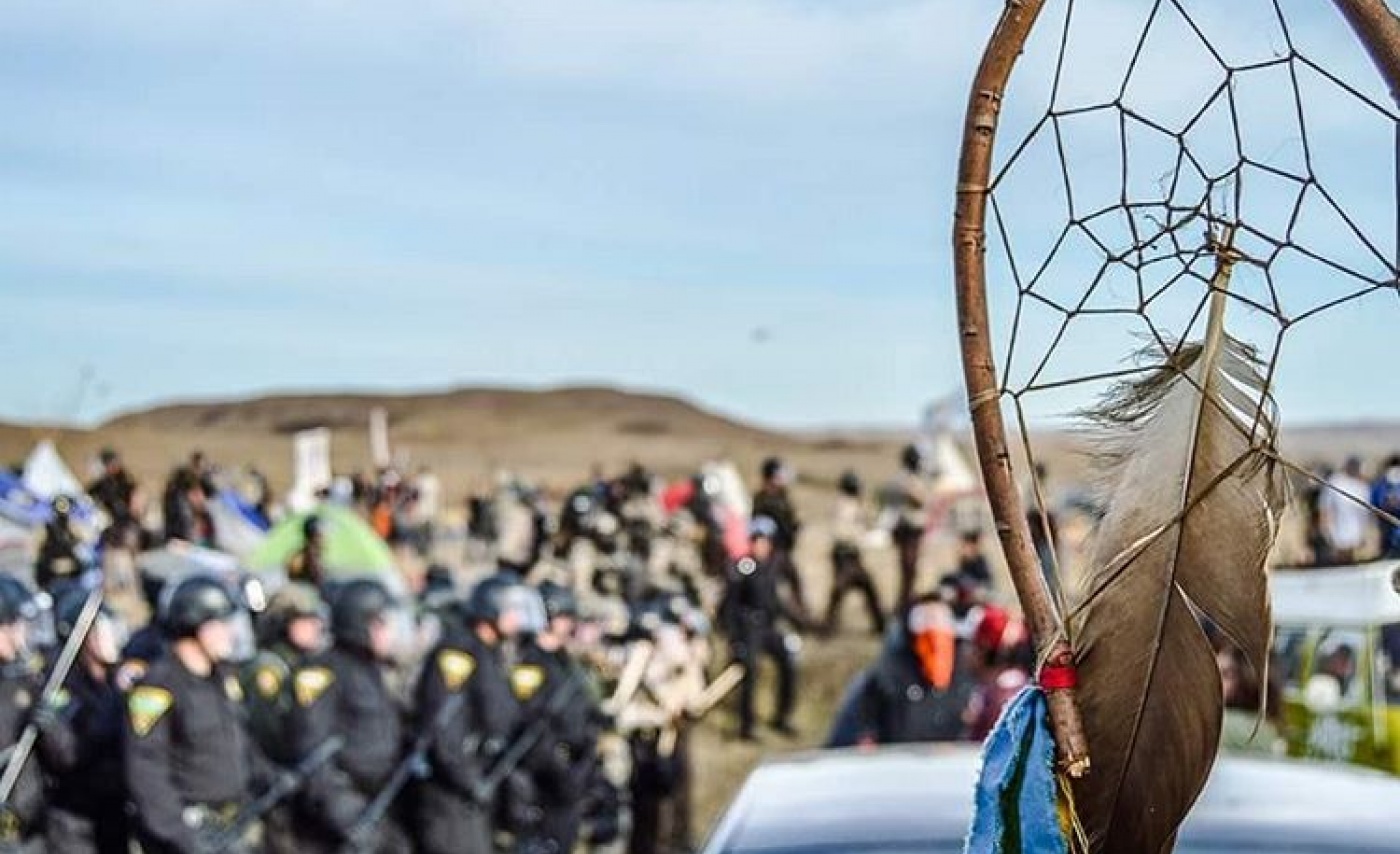
by Deep Green Resistance News Service | Nov 14, 2016 | Lobbying
by Cultural Survival
“We call upon all member states, to condemn the destruction of our sacred places and to support our nation’s efforts to ensure that our sovereign rights are respected. We ask that you call upon all parties to stop the construction of the Dakota Access pipeline and to protect the environment, our nation’s future, our culture and our way of life.”
– Standing Rock Sioux Tribe Chairman Dave Archambault II
The International Indigenous Peoples`Forum on Climate Change (IIPFCC) condemns the construction of the Dakota Access pipeline and stands in solidarity with our sisters and brothers of the Standing Rock Sioux Tribe and all Water Protectors in opposition to this project.
Human Rights and the Indigenous Rights Perspective
The Dakota Access pipeline is being built on the un-ceded treaty lands of the Standing Rock Sioux Tribe, without their free, prior and informed consent, as is described in the UN Declaration on the Rights of Indigenous Peoples in Articles 18, 19, and 32. The pipeline is also being constructed through sacred areas and ancestral burial grounds of the Standing Rock Sioux and other Indigenous Peoples of the area. This massive construction project does not respect the Standing Rock Sioux’s Treaty rights, sovereignty, or their right to self-determination. It is an outright violation of their rights over their lands and resources as Indigenous Peoples, and does not respect the human rights of Indigenous Peoples.
Climate Perspective
The Dakota Access pipeline will transport 470 000 – 570 000 barrels of oil every day, which will release emissions of 101,4 million tonnes CO2, as much as 30 American coal power plants, every year. This is not consistent with the State Parties’ obligations and commitments under the Paris Agreement or the Sustainable Development Goals (SDGs). The continued production of fossil fuels only assures that global temperature will rise well above 2°C in the immediate future and threaten the lives and livelihoods of Indigenous Peoples around the world. The potential for a major oil spill from the Dakota Access pipeline is immediate. The pipeline is scheduled to cross underneath the Missouri River, which is the main source for drinking water for the Standing Rock Sioux Reservation and for millions of people who live downstream. Sunoco Logistics, the operating company of the pipeline, alone has experienced over 200 oil spills in 6 years, and the US had in total over 3300 leaks since 2010, polluting rivers, ground waters, land and air, and both human lives, health and livelihoods has been lost.
The IIPFCC calls upon the US to halt the construction of the Dakota Access pipeline and to enter into serious consultations with the Standing Rock Sioux, and other tribes affected by this project, respecting the right of the Tribes to free, prior and informed consent.
The state owned Norwegian Oil Fund is heavily invested in the pipeline. The IIPFCC calls upon Norway to divest from the Dakota Access pipeline Project.
We also call on all States to ensure the protection of Indigenous Peoples´ territories across the world as a critical action in the implementation of the Paris Agreement and in achieving the SDGs.
Featured image by A. Golden/Flickr.

by Deep Green Resistance News Service | Nov 9, 2016 | Culture of Resistance
by Jennifer / Deep Green Resistance
I have traveled to Standing Rock twice now. The first time was on September 16 – 20. On the first trip I went with my mother. We camped at Rosebud and spent a great deal of time in the kitchen preparing food and talking with members of the camp, indigenous and non-indigenous allies. We could hear prayers and drumming in the Oceti Sakown Camp well into the night. The atmosphere was of constant prayer and felt celebratory. There were fireworks on the first night of our stay. I visited Sacred Stone and the “Overflow,” Oceti Sakowan, camps. Between Rosebud and Sacred Stone a women’s lodge was being constructed, with the permission of the elders.
The second trip was on October 29 – November 2. I went with acquaintances and we camped in the Oceti Sakowan. We fed ourselves, and provided our own shelter. The only time I ate outside of our camp was when I went to do dishes at Rosebud. Surveillance was present on the hill overlooking the camp: flood lights, drones, plane helicopter circling. I did not take pictures. The camp itself was much quieter. I attended non violent civil disobedience training, a requirement for all new arrivals. I filled out forms with legal and prepared for the possibility of NVCD action.
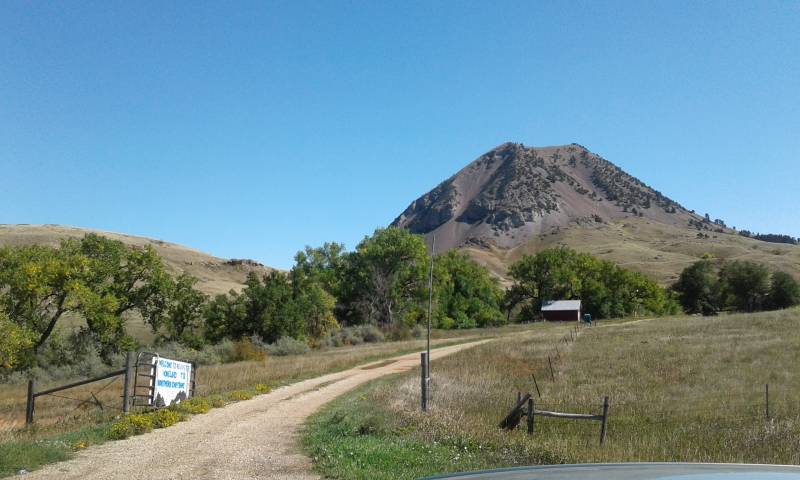
I also went to an orientation for the medics. Currently a Medic tent, herbal/alternative remedy, and a body work tent have been established with a mental health group and center in formation. Meetings for the camp are held every morning and in a truly respectful and democratic manner. All voices are heard. From 2-3 hours of work a day are expected to be given to the collective. I participated in water ceremony by invitation. I gave my drum when it was asked for, to be in sweat lodge. I visited Sacred Stone, and spoke with a keeper of the sacred fire who had just returned to camp, having closed down her life a half a continent away to be at Standing Rock.
Building for the winter was well underway. Between Sacred Stone and Rosebud on the Standing Rock Reservation side of the Cannonball, the women who were building the women’s lodge had returned and were well established; the lodge was complete. Rosebud looked the same physically, but many people who I remembered had left while some remained. I had a brief conversation with a Episcopalian Minister letting me know that 300 faith leaders were answering the call to come to Standing Rock. Over 500 arrived the day after our departure.
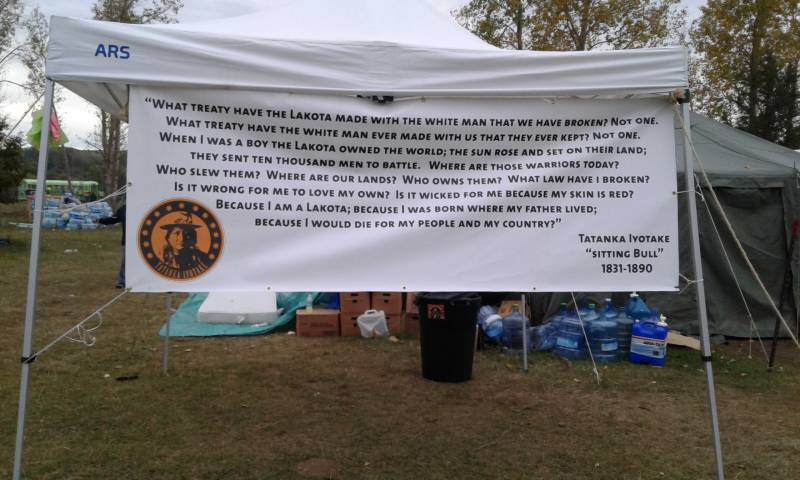
I was physically cold, in pain, and sleep-deprived during the stay. Monday was particularly difficult and windy. Recent tests indicate I most likely have a severe form of arthritis. Fortunately be were camped by some trees and able to create a bit of a wind break. If you are planning to go, be prepared for harsh conditions and be realistic about your limitations and how to deal with them.
I have attended multiple Wednesday evening updates at Four Winds in Denver. I have learned a great deal about the legal and on-the-ground struggles, not only at Standing Rock but historically, by attending updates. These meetings have also led to engagement with an organizing group of women who coordinated Four Directions March and Prayer in solidarity with Standing Rock and on Indigenous Peoples Day (transforming Columbus Day), prayer and ceremony for Murdered and Missing Sisters, and on election day will be holding a Million Mothers March in Denver. I have been able to engage in support work by request and have been able to offer air time through WomynAir and the AM News Magazine on our local community radio station KGNU to increase awareness and notify the public when it is appropriate for them to attend.
In Conclusion: Standing Rock is a functional, resilient community of resistance. Standing Rock is prayer and ceremony and community. If there is anything that I have gathered from having been at Standing Rock it is this. Prayer and ceremony unite the people to the land, air, and water; to each other, to our ancestors, to community, to action. It is my belief, after my experience of being at Standing Rock, that this foundation gives humans the strength and sanity to face ourselves, our communities, life, and to continue to take action in defense of life. Words fail. I will continue to listen.

by Deep Green Resistance News Service | Nov 2, 2016 | Biodiversity & Habitat Destruction, Colonialism & Conquest
Featured image: World Wildlife Fund trustee Peter Flack with dead forest elephant. © Survival International
by Survival International
Survival International has learned that an elephant-hunting safari operation jointly owned by a French billionaire has been implicated in human rights abuses against local Baka “Pygmies” and their neighbors, including illegal evictions and torture.
The operation is based in two “protected areas” in Cameroon, leased by Benjamin de Rothschild. It offers tourists the chance to pay €55,000 to shoot a forest elephant.
Baka were evicted from their ancestral land to create the trophy hunting operation, contrary to international law. It is patrolled by soldiers, police and armed guards, and Baka have now been told they will be shot on sight if they cross it to hunt to feed their families, gather plants, or visit religious sites.
The Baka report that three of their forest camps have been burnt by wildlife guards and safari camp employees in the last year alone. Baka men hunting for food in this forest have been beaten by local police, soldiers and wildlife guards.

Benjamin de Rothschild, joint owner of a luxury elephant-hunting operation on Baka land
© JeuneAfrique
One Baka man told Survival: ”They told me to carry my father on my back. I started walking, [the guard] beat me, he beat my father. For three hours, every time I cried out they would beat me, until I fainted and fell to the ground with my father.”
Another Baka man said: “When the trophy-hunting company finds us here they burn the camps. They beat us, they search for us, they set their dogs on you, their guns on you.”
A third Baka said: “The trophy-hunting company said that if they see anyone [in the forest] bullets will fly. Now those who have family there have gone to get them out. How will we live now?”
Survival contacted Mr. de Rothschild informing him of reports of serious human rights abuses having been committed to maintain the trophy-hunting operation, but has received no reply.
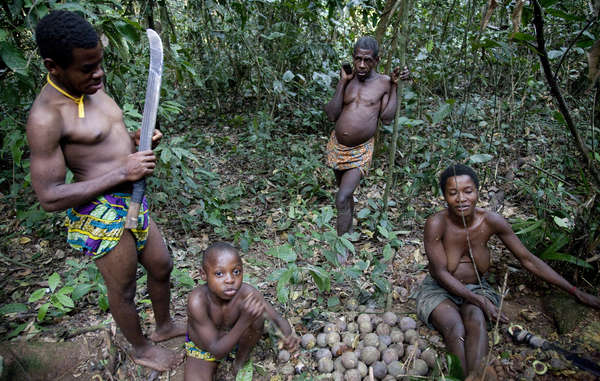
The Worldwide Fund for Nature (WWF) is very active in Cameroon, and the trophy-hunting “protected areas” form part of one of their key “conservation landscapes.” WWF has yet to comment on the allegations, or say whether it proposes to take any action.
One booking operator told Survival that: “All our luxurious fully equipped forest camps are solid construction, air conditioned with private chalets with full bathrooms and dressing parlors. Delicious multi-course cuisine is served with top shelf European wines and beverages… Our newest forest camp has a large screened in swimming pool.”
Watch: Baka plead for forest guards to leave them in peace.
© Survival International
Across the region, Baka “Pygmies” and their neighbors are being evicted from their ancestral homelands and face arrest and beatings, torture and even death while big game trophy-hunting is encouraged. WWF trustee Peter Flack has also hunted elephants in the region.
Survival’s Director Stephen Corry said: “Across Africa, rich trophy hunters are welcomed into the same areas where tribal hunters are illegally evicted from their ancestral homelands and brutalized for hunting to feed their families. This has to stop. Conservation in the Congo Basin is land theft, a continuation of colonialism. It leads to widespread and horrific human rights violations, including extrajudicial killing. Why are so few people speaking out? Survival is leading the fight against these abuses. Conservationists must respect human rights like everyone else is supposed to.”
Click here to find out more and take action.
This is not an isolated incident. Across Africa, tribal people are accused of “poaching” because they hunt to feed their families. And they face arrest and beatings, torture and death, while big game trophy hunters are encouraged. Survival International is leading the fight against these abuses.
Note: “Pygmy” is an umbrella term commonly used to refer to the hunter-gatherer peoples of the Congo Basin and elsewhere in Central Africa. The word is considered pejorative and avoided by some tribespeople, but used by others as a convenient and easily recognized way of describing themselves.
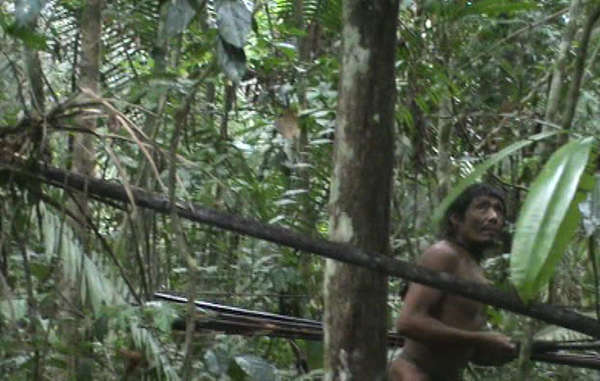
by Deep Green Resistance News Service | Oct 28, 2016 | Colonialism & Conquest
by Survival International
Waves of loggers are invading the territory of one of the most vulnerable peoples on the planet. The Indians, known as the Last of the Kawahiva, are the survivors of a larger tribe who have been killed or died of disease.
One group of loggers was recently caught by agents from FUNAI, Brazil’s Indigenous Affairs department. However, as the loggers have local political support, and FUNAI agents do not have the power to arrest suspects, the men were released. Further waves of loggers have since entered the territory.
The crisis has raised concerns among campaigners that the tribe and their rainforest home could be destroyed entirely.
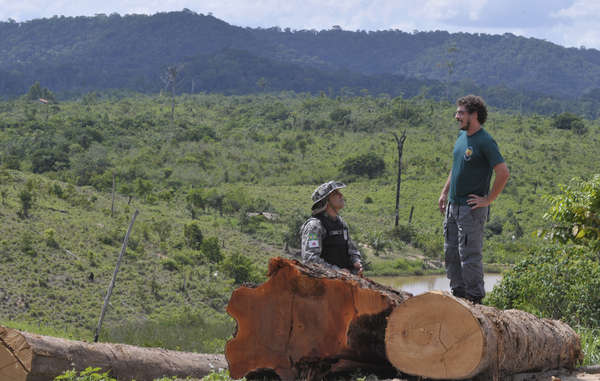
FUNAI agents work in many parts of Brazil to protect indigenous territories from loggers and other threats. © Mário Vilela/FUNAI
In April 2016, the Brazilian Minister of Justice signed a decree to create a protected indigenous territory on the tribe’s land to keep loggers and other intruders out. This was a big step forward for the Kawahiva’s lands and lives, and followed pressure from Survival’s supporters around the world. However, the decree has yet to be properly enacted and now the small team who are working to protect the land are facing severe budget cuts.
Jair Candor, an experienced FUNAI agent, said: ”The Kawahiva are trapped. If any contact happens, it will be devastating for them. The only way to ensure their survival is to map out the land and put in place a permanent land protection team. Otherwise, they will be relegated to the history books, just like so many other tribal peoples of this region.”
Oscar-winning actor Mark Rylance has narrated a film to highlight the tribe’s plight.
Survival’s Director Stephen Corry said: “Brazil committed to protecting the Kawahiva’s land in April, but with the government dragging its heels an urgent and horrific humanitarian crisis is unfolding. The Kawahiva’s land is still being invaded and their forest is still being destroyed. It’s time for Brazil to take action as it promised, before the genocide of an entire people is complete.”












